
Volume 24, No 8, Aug 2014
ISSN: 1001-0602
EISSN: 1748-7838 2018
impact factor 17.848*
(Clarivate Analytics, 2019)
Volume 24 Issue 8, August 2014: 994-1008
ORIGINAL ARTICLES
A Smad3 and TTF-1/NKX2-1 complex regulates Smad4-independent gene expression
Kazunobu Isogaya1, Daizo Koinuma1, Shuichi Tsutsumi2, Roy-Akira Saito1,3, Keiji Miyazawa1,4, Hiroyuki Aburatani2 and Kohei Miyazono1
1Department of Molecular Pathology, Graduate School of Medicine, The University of Tokyo, Bunkyo-ku, Tokyo 113-0033, Japan
2Genome Science Division, Research Center for Advanced Science and Technology (RCAST), The University of Tokyo, Meguro-ku 153-8904, Japan
3Department of Respiratory Medicine, Graduate School of Medicine, The University of Tokyo, Bunkyo-ku, Tokyo 113-0033, Japan
4Department of Biochemistry, Interdisciplinary Graduate School of Medicine and Engineering, University of Yamanashi, 1110 Shimokato, Chuo, Yamanashi 409-3898, Japan
Correspondence: Kohei Miyazono, Tel: +81-3-5841-3345; Fax: +81-3-5841-3354 E-mail: miyazono@m.u-tokyo.ac.jp; Daizo Koinuma, Tel: +81-3-5841-3345; Fax: +81-3-5841-3354(koinuma@m.u-tokyo.ac.jp)
Thyroid transcription factor-1 (TTF-1, also known as NKX2-1) is a tissue-specific transcription factor in lung epithelial cells. Although TTF-1 inhibits the epithelial-to-mesenchymal transition induced by transforming growth factor-β (TGF-β) in lung adenocarcinoma cells, the mechanism through which TTF-1 inhibits the functions of TGF-β is unknown. Here we show that TTF-1 disrupts the nuclear Smad3-Smad4 complex without affecting the nuclear localization of phospho-Smad3. Genome-wide analysis by chromatin immunoprecipitation followed by sequencing revealed that TTF-1 colocalizes with Smad3 on chromatin and alters Smad3-binding patterns throughout the genome, while TTF-1 generally inhibits Smad4 binding to chromatin. Moreover, Smad3 binds to chromatin together with TTF-1, but not with Smad4, at some Smad3-binding regions when TGF-β signaling is absent, and knockdown of Smad4 expression does not attenuate Smad3 binding in these regions. Thus, TTF-1 may compete with Smad4 for interaction with Smad3, and in the presence of TTF-1, Smad3 regulates the transcription of certain genes independently of Smad4. These findings provide a new model of regulation of TGF-β-Smad signaling by TTF-1.
10.1038/cr.2014.97
FULL TEXT | PDF
Browse 2233


